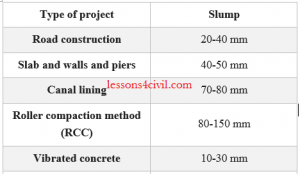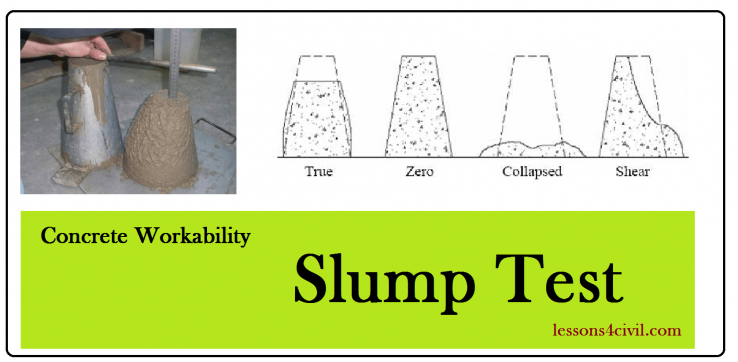Concrete Workability
Concrete workability means how easy the concrete mixture can be placed in during the molding process. In simple words the looser the mixture is, the higher workability it has. To quantify and report the workability of the freshly mixed concrete we use a parameter called “Slump”. Slump test is an innovative simple test during which we cast the mixture in a coned-shaped bucket and when we raise the bucket, the height of deformation is reported as “slump”. So briefly, higher amount of slump represent a looser mixture. In this article I am going to remark some of the most important points about concrete workability and slump test.
Rang of concrete workability
Depending on the result of slump test we can say there are 3 types of concrete mixture:
- a) Unworkable Concrete: It happens when the concrete mixture is too harsh for proper implacement. As a result working with such a mixture is quiet impossible because it cannot reach all parts of the mold. Unworkable concrete is usually when the ratio of water to cement is less than 0.4.
- b) concrete with medium workability: this type of workability is what engineers are seeking to achieve the best results. When the ration of water to cement is greater than 0.4 and less than 0.6, so that the most suitable workability is expected. In this case the mixture placed easily without segregation. In most cases with light reinforcement we can use a medium workable mixture.
- c) Concrete with high workability
in some structures the density of steel reinforcement is high. As a result, the free spacing between bars is less than usual practices. In such projects we need to use a highly workable concrete, otherwise it cannot be fed between bars. To produce a highly workable concrete the water to cement ration should be greater than 0.6
Concrete workability is a function of…..???
Following factors define how workable the concrete mixture is going to be.
- The ration of water content to cement
- Reinforcement details
- Freshness of concrete mixture
- Method of concrete placement
- The temperature
Does workability reduce the strength?
Many people think a higher workability associates with a reduction in strength. However this conclusion is to some extent true, but to be more precise, it depends on the method we use to increase the workability of the mixture. For example modification of aggregates is a factor that helps to reach higher workability without a considerable loss in strength. On the other, increasing the amount of water makes the concrete considerably weaker. Remember, water is the greatest enemy for concrete. The following graph gives an estimation on how increase in workability affects of stresngth of concrete mixture. As you can see in the figure bellow, for a fully compacted concrete, adding water constantly reduces the its strength. On the other hand, in case of insufficiently compacted mixtures, say hand compaction, the red line implies that there in an optimum water/cement ratio to reach the highest strength.

The recommended range of slump values
The suitable amount of workability depends on the type of project. Table below offer a recommendation for different purposes:

Recommended Slump Values
Other tests to measure workability
Until now we were talking about the most frequently used test to measure the workability of concrete, “Slump Test”. But there are 2 other similar tests for workability including:
1. Compaction factor test:
Compaction factor test is a laboratory test that reports the ratio of weights of partially compacted to fully compacted mixtures of concrete. The invention of this test is issued by Road Research Laboratory. Briefly, as you can see the aparatus consist of 2 hoopers and one cylinder. In this test concrete mixture is filled in the upper hooper and pass through the secound hooper t be finally placed in the cylinder. weight if cylinder with concrete iside it is recorded as W1. one more time we repeat the process, only this time the mixture is compacted in several layers at the upper hooper. The weight of cylinder is recorded again as W2. The formula bellow shows the compaction factor, where W is the weight of empty cylinder. you can also watch a vido linked in below to get the gist of this test.
Compaction Factor Value= (W1-W) / (W2-W)
2. Vee-bee consistometer test:
You can see the related equipment of this test in figure bellow. Regardless of precise description of this test, I want to explain how it works in simple words. The aparatus consist of a cone, a vibrating table and a tamping rod. After the cone is filled with 4 layers of compacted concrete. This is the first molding of concrete. Next a hatch is opend and llows the concrete to fall down and remold in the cylinder beneath. Time reqired for this remolding process is an indicator of concrete workability. Here is a video giving more insight into this test.



Comments